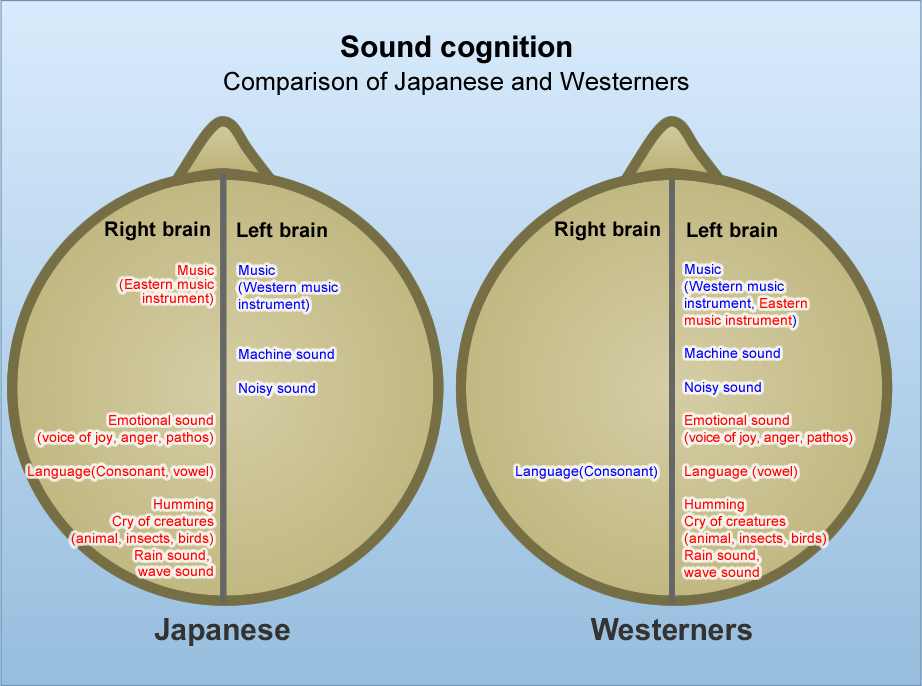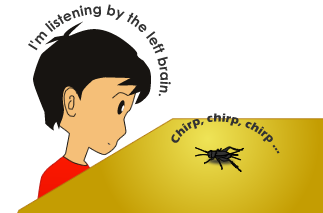- HOME
- Ono Sokki's Patio
- Sound & Brain

Sound & Brain
Ken: Is it true that sounds entered through the ears are processed differently between Japanese and Westerners?
Dad: An article based on a research done more than 30 years ago by Professor Tsunoda is the origin. This information became widely known by his book "The Brains of Japanese."
Ken: What differences are there?
Dad: First, you know that the brain has a left and a
right side. There's a graph ((  Diagram 1Reference 1) that
indicates the brain activity to various sounds,
comparing Japanese to Westerners. I'll explain using
that. (Putting the cursor over
"Diagram 1" displays the diagram.)
Diagram 1Reference 1) that
indicates the brain activity to various sounds,
comparing Japanese to Westerners. I'll explain using
that. (Putting the cursor over
"Diagram 1" displays the diagram.)
It can be said that the left brain is the language brain and the right brain is the music brain or artistic brain, and the role of the left is for rational cognition and the right is for emotional cognition. In the left brain of Japanese, however, the rational cognition and emotional cognition coexists.
Ken: When you look at this graph, you can see Japanese listen to more sounds using the left brain, as compared to Westerners.
Dad: Yes. The main characteristic of Japanese is that the left brain is listening to the vowel sounds. Professor Tsunoda's initial experiment was to find which side of the brain strongly received the language and non-language. The sound used in the experiment for the non-language sound was a simple 1 kHz tone, and for the sound representing the human languages was a continuous long vowel "A".
Ken: So Professor Tsunoda made the people from different countries listen to the experiment sounds and researched which brain listened to the sound?
Dad: Yes. To identify the brain's active part, an fMRI (functional magnetic resonance imaging), which detects the change in the brain's blood flow, is used now. But at that experiment, an analog device that measures the conversion mechanism of the brainstem system to decide which side of the brain is being used to process sound was used. Some researchers doubted the credibility of the result, but further experiment was done by another researcher using brain waves and MEG (Magneto-encephalography).
Ken: Was the result the same result as that of Professor Tsunoda
Dad: Yes. In response to the vowel sound stimulus, the result was that Japanese's left brain activated and American's right brain activated, providing proof to Professor Tsunoda's discovery. (Reference 2) Also insect sounds, such as cricket, showed the same tendency.
Ken: In (  this graph
(Diagram 1), Eastern music instrument means Japanese music instrument,
right? It's mysterious that Japanese uses the left brain for Japanese
music instrument and the right brain for Western music instruments. The
sound of shamisen, we analyzed before, do Japanese use the left brain to
hear but Westerners uses the right brain?
this graph
(Diagram 1), Eastern music instrument means Japanese music instrument,
right? It's mysterious that Japanese uses the left brain for Japanese
music instrument and the right brain for Western music instruments. The
sound of shamisen, we analyzed before, do Japanese use the left brain to
hear but Westerners uses the right brain?
Dad: Yes. That is also a characteristic difference. Japanese receives Japanese music instrument and nature sound that has a vowel structure with the left brain. The reverberation of a bell at the temple might be heard as a vowel sound as well.
Ken: How about the people from other Asian countries or Japanese that were raised overseas?
Dad: It is said that the special characteristics of Japanese brain are all attributable to the Japanese language. So Koreans and Chinese are similar to Westerners and even if one is Japanese, if Japanese isn't the native language, they have similar brain structure as Westerners.
Ken: Japanese listens to insect sounds with the language brain of the left brain?

Dad: Even for insect sounds, Japanese have a special way of hearing them. I have many entertaining story about insect sounds, so I'll tell you all about it another time.
Ken: If Japanese have a different sensation to sounds compared to other countries, is there any problem that could come about that?
Dad:It cannot clearly be stated that Japanese has different senses, but there's a big difference from other nations, especially with nature sounds like insects and rain. Japanese just don't hear it as a sound; but they feel seasons, overlap people's emotions and look for meaning in it. This may have influences on the Japanese culture of accepting the nature instead of confronting it. Japanese should be more self-aware about it.
*Reference 1: Structure of Sound Sense and Culture
(Interview with Tadanobu Tsunoda) in "The Root of Music", Fumio Koizumi,
Heibonsha Publishing
*Reference 2: "Japanese Brain Doesn't Need Subject", Hiroshi Tsukimoto,
Kodansha, Ltd.
- © ONO SOKKI CO., LTD. 1996-2025
